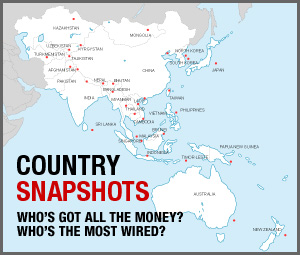Sun to set on US role in APAC?
 Image: Beverly & Pack
Image: Beverly & Pack
Unlikely, says US scholar Robert Sutter, who argues no other power in the region is ready–or willing–to step into America’s shoes.
Despite the enormous challenges it has faced since World War II, US leadership in the Asia-Pacific has proven to be remarkably durable. Indeed, despite serious questions being raised about whether the United States and its often weak allies could hold the line against the expansion of Sino-Soviet communism, the US presence in the region emerged from the Cold War intact.
But the past six decades have not been easy. The low point of Washington’s influence came with the failure of its military support for non-communist governments in Indochina, which coincided with major economic and political crises in the United States. And although US leaders adroitly aligned with Maoist China to deal with the common threat of Soviet expansion after the Soviet-backed Vietnamese Communist troops smashed through the gates of the Presidential Palace in Saigon in 1975, the USSR was widely seen as Asia’s ascendant power. The United States, meanwhile, looked to be in clear decline.
Challenges to the United States’ place in the Asia-Pacific continued in the 1980s–despite the revitalization of American strategic power and its resolute stance against the Soviet ‘evil empire’–as a different kind of power transition was said to be underway. This time Japan, with its extraordinary economic capabilities, was widely seen as set to become the dominant force in the region, marginalizing American leadership at a time when the United States seemed unable to compete with Japanese entrepreneurs at home and abroad. This analysis, with its assumption that the United States would be unable to sustain a leadership position in the Asia-Pacific, lasted more than a decade.
And now, in the 21st century, US leadership is again seen as waning, this time in the shadow of a rising China. Yet these latest predictions of decline tend to follow the same erroneous pattern of earlier predictions: emphasising the strengths of the current rising power, while too often failing to give adequate attention to its weaknesses and limitations. American weaknesses, meanwhile, are typically exaggerated, while its strengths are not always given their due.
A more balanced assessment of strengths and weaknesses suggests that much of the analysis surrounding the latest challenge to the US position as leading power in the Asia-Pacific is misplaced. It may be a controversial view among some observers, but this author believes that the United States is well positioned to maintain its dominance through the next decade, and that any assessment of decline must be measured against four important yardsticks of US strength.
A Constantly Evolving Picture
US policy and leadership in the Asia-Pacific has come in for strong criticism over the past decade from a range of sources–media and specialist commentary as well as popular and elite opinion. Topping the litany of complaints was the hard-line policy adopted by the administration of George W. Bush toward North Korea, its military invasion and occupation of Iraq, and apparently unilateral US approaches on issues ranging from terrorism to climate change, the United Nations to Asia-Pacific regional organizations. The United States appeared alienated and isolated, and increasingly bogged down with the consequences of its invasion of Iraq and perceived overemphasis on the so-called war on terrorism.
By contrast, the Asia-Pacific’s rising powers–particularly China–have often seemed to be advancing rapidly. China has used effective diplomacy and rapidly increasing trade and investment relationships, backed by double-digit economic growth, to broaden its influence throughout the region. Meanwhile, it has achieved steady and significant increases in its military strength.
The focus on Chinese strengths and US weaknesses spawned numerous books and reports by governments and respected international study groups and think tanks, all with a common prediction: the Asia-Pacific was adjusting to an emerging China-centred order and US influence was in decline.
But the reality soon proved to be more complex. Japan clearly was not in China’s orbit, while India’s interest in accommodation with China was mixed and anyway overshadowed by a remarkable upswing in strategic cooperation with the United States. Russian and Chinese aligned interests, meanwhile, waxed and waned and appeared to remain secondary to their respective relationships with the West. And South Korea, arguably the area of greatest advance in Chinese influence against a backdrop of major tension in the US-ROK relationship earlier in the decade, saw dramatic changes beginning in 2004, culminating in often wary South Korean relations with China. This temporary honeymoon effect was also in evidence with Australia.
Beijing, meanwhile, often found the association of Southeast Asian Nations ineffective in pursuing the multilateral initiatives it supported and saw its ascendance in Southeast Asia tempered by the revitalization of now democratic Indonesia, the region’s longstanding leader and the Southeast Asian power least likely to bandwagon with China.










